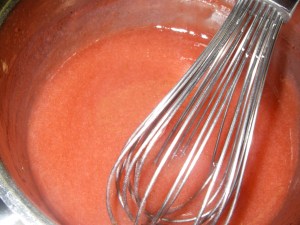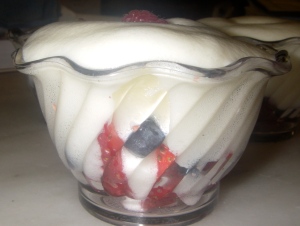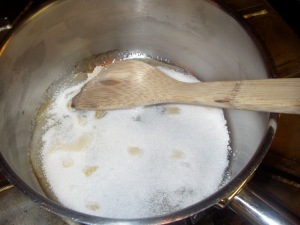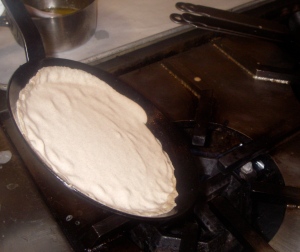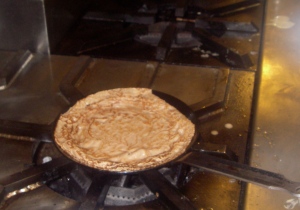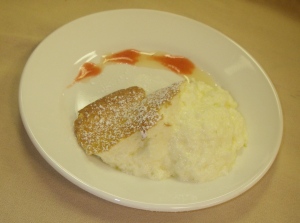Dessert sauces are based on fruit, custard, caramel, chocolate, butter, or wine. A whole class devoted to dessert sauces wouldn’t be much without something to sauce, so in this class, we also made some crêpes and soufflés.
Fruit sauces and coulis are made from pureed fruit. Coulis is fruit that’s pureed and strained. Sauce is pureed fruit, usually strained (and therefore a coulis) that has butter or cream added to it. Depending on the flavor of the fruit, you might need to add a little simple syrup or lemon juice. Any fruit that’s very hard or fibrous (e.g., apples, pears, quinces) has to be cooked first, but many fruits, such as raspberries, can be used fresh and raw.
Crème anglaise is one of the most common dessert sauces. Any monkey can make a crème anglaise, says Chef Sharon, but it takes a pastry chef to make it right, so I’d better practice this one. Crème anglaise is a lot like pastry cream: It’s made with milk, egg yolks, and sugar. You can change the texture by adding cream or egg yolks, and you can change the flavor by adding vanilla or another flavoring. Pastry cream has starch, too, to stabilize it; crème anglaise doesn’t, so you have to be careful not to let it boil. Crème anglaise is done when it coats the back of a spoon; you wipe your finger over the back of the spoon, and if the line stays for 3 seconds, the sauce is done. Because it’s so important to make sure the sauce doesn’t overcook, you have to have an ice bath ready to set the bowl in. The other difference is that with pastry cream, you get your upper-body workout by whisking like mad, but with crème anglaise you must only stir and never whisk because whisking makes the sauce foam, and the foam doesn’t go away (as it does with pastry cream).
Sabayon (or zabaglione) is a light custard. It’s made with sugar, egg yolks, and sweet wine, usually marsala. The wine is very important in sabayon because a well-made sabayon always retains the wine flavor. You want to taste the wine and make sure you like it, and it’s important to use really good wine. Sabayon is good with fresh fruit. You need to make it at the last moment because it deflates quickly, but you can make a sabayon mousse with gelatin added to stabilize it.
Chocolate sauce is a combination of melted chocolate plus cream, milk, egg yolks, and butter (in some combination); it also can be made by adding grated chocolate to crème anglaise. If you want a flowing sauce, you use more liquid than chocolate; if you want a stiff sauce, you use less liquid. To make frosting, you use equal parts cream and chocolate; this is a classic ganache. White chocolate is tricky because it’s mostly fat (white chocolate is cocoa butter with some other things added). To make a sauce (or ganache) with white chocolate, you can’t use cream because all that fat will keep the sauce from holding together; you have to use skim milk or 1%.
Caramel is the last stage of cooked sugar syrup before the sugar carbonizes. The carbonizing stage is one you want to avoid at all costs: It stinks, the smoke damages your lungs, and it irretrievably ruins your saucepan. Caramel is plain cooked sugar, but caramel sauce has butter added and sometimes cream and other things. Suzette sauce (for crêpes Suzette) is caramel with butter, warm citrus juices (usually lemon and orange), and brandy or cognac.
We started with fruit sauce and fruit coulis. Raspberry sauce is one of the most common in a restaurant, and Chef Sharon encouraged us to consider other things. My partner and I chose to make strawberry sauce and strawberry coulis. Raspberry is darker and what you usually see on your plate in a restaurant. The strawberry is pink rather than red; I’m not sure when that would be a better choice for color; maybe with other pastels or as a contrast to something dark.
The strawberry sauce is a little darker; it’s pretty, but still not dark enough to use just as a decoration (unless you need this particular color). They’re both delicious, though.
We thought of using Riesling in our sabayon, but there wasn’t enough, so we used Cava instead. That might have been a mistake, because our sabayon was extremely light owing to the carbonation in the wine.
For our caramel sauce we thought it would be fun to do Suzette sauce so we could make crêpes Suzette. We were all making crêpes anyway, so this struck us as a golden opportunity. In a very clean saucepan, you put granulated sugar. Then you put that over a flame and watch it change from a pan of sugar:
to a pan of caramel:
Your caramel is done when it has the right color and fragrance, and these are up to you; just don’t let it carbonize! We added butter, orange juice, and lemon juice to the caramel and set the sauce aside to await our crêpes.
Crêpes aren’t difficult, but they take a little practice. The batter is very thin, and it has to rest for awhile, so we had already made our batter. We thought cinnamon would go nicely with the citrus Suzette sauce, so that was the flavor we used. The school has proper crêpe pans, but you can use a small skillet, say, 6 or 8 inches in diameter. You brush the hot skillet with melted butter.
Then you pour some batter into the pan while you swirl the pan so the batter evenly coats the pan. The pan is hot, so the batter cooks pretty quickly and you have to work fast.
When it’s cooked on the first side, which takes almost no time, you flip it over. It doesn’t take long to cook on the second side, either.
Then Chef Sharon made the crêpes Suzette, but she used chocolate crêpes instead of the cinnamon ones. I’ll try this at home with cinnamon crêpes. You fold the crêpes into quarters, which apparently is a traditional way of serving crêpes, and cook them in the sauce with orange suprêmes (orange sections removed from their membranes).
Then she poured on some Grand Marnier and lit the sauce with a blowtorch.
And here it is on the plate:
We plated our cinnamon crêpes with our chocolate sauce:
We also made a lime soufflé.
We plated a portion of that with our strawberry sauce and crème anglaise.


